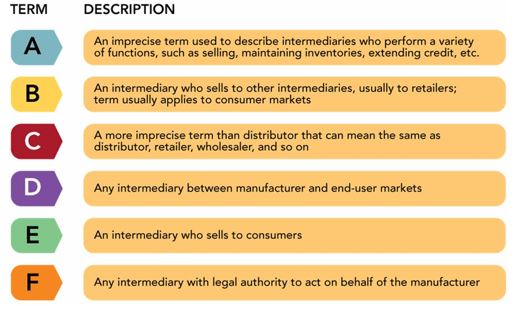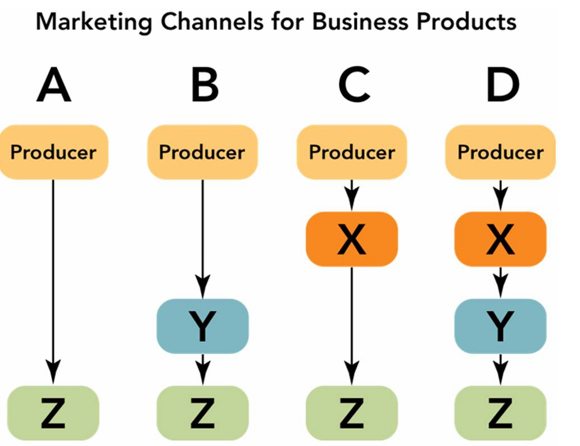A) the distribution of products or services in markets where there are currently no other competitors.
B) the distribution of products or services where the producer owns the entire channel of distribution.
C) the density of distribution whereby a firm tries to place its products or services with only one retail outlet in a specified geographical area.
D) the density of distribution whereby a firm tries to place its products or services in as many outlets as possible.
E) the density of distribution whereby a firm tries to place its products or services in a few retail outlets in a specific area.
G) C) and E)
Correct Answer

verified
Correct Answer
verified
Multiple Choice
 -A variety of terms are used for marketing intermediaries. According to Figure 12-1 above, E represents a(n) __________.
-A variety of terms are used for marketing intermediaries. According to Figure 12-1 above, E represents a(n) __________.
A) retailer
B) middleman
C) wholesaler
D) distributor
E) agent or broker
G) A) and C)
Correct Answer

verified
Correct Answer
verified
Multiple Choice
Items such as large household appliances that require installation, delivery, and credit should be sold by retailers that demonstrate the buyer requirement of __________.
A) information
B) convenience
C) variety
D) pre- or postsale services
E) adaptability
G) C) and D)
Correct Answer

verified
Correct Answer
verified
Multiple Choice
A channel that includes intermediaries that are between the producer and consumers and perform numerous channel functions is referred to as a(n)
A) indirect channel.
B) direct channel.
C) multilevel channel.
D) full-service channel.
E) limited-service channel
G) A) and E)
Correct Answer

verified
Correct Answer
verified
Multiple Choice
Which of the following statements regarding corporate vertical marketing systems is most accurate?
A) Corporate vertical marketing systems require all links in the marketing chain to share title to the goods passed through these firms.
B) Corporate vertical marketing systems can incorporate both forward and backward integration.
C) Corporate vertical marketing systems increase distribution costs.
D) Corporate vertical marketing systems increase investment increases but decrease fixed costs.
E) Corporate vertical marketing systems are only effective with low-end consumer products.
G) C) and D)
Correct Answer

verified
Correct Answer
verified
Multiple Choice
The output of a supply chain is the
A) units of products delivered.
B) total generated revenue.
C) service delivered to customers.
D) total number of customers served.
E) total profits realized.
G) All of the above
Correct Answer

verified
Correct Answer
verified
Multiple Choice
Those activities that focus on getting the right amount of the right products to the right place at the right time at the lowest possible cost are referred to as
A) strategic distribution.
B) distribution management.
C) tactical marketing planning.
D) value chain optimization.
E) logistics.
G) A) and E)
Correct Answer

verified
Correct Answer
verified
Multiple Choice
While Maytag appliances have the leading brand name, its sales are third in the industry. One of the things the company has done to spur sales is to create a website where potential customers can find the answers to the questions they ask during the appliance purchase process. Although Maytag considered using a __________ strategy by directing customers to Maytag appliance stores it owns, the firm decided against it and simply provides the names and addresses of all the retailers (Sears, Home Depot, etc.) that carry Maytag appliances.
A) horizontal channel strategy
B) strategic channel alliance
C) dual distribution
D) cross-docking
E) disintermediation
G) B) and E)
Correct Answer

verified
Correct Answer
verified
Multiple Choice
 -Figure 12-4 above depicts the four most common marketing channels for business products and services. Channel D would be an appropriate marketing channel for __________.
-Figure 12-4 above depicts the four most common marketing channels for business products and services. Channel D would be an appropriate marketing channel for __________.
A) Cray supercomputers
B) Harkman electrical products
C) Boeing aircraft
D) Caterpillar tractors
E) Fastenal industrial fasteners
G) A) and E)
Correct Answer

verified
Correct Answer
verified
Multiple Choice
One of the sales growth strategies Amazon considered early on is (the) __________.
A) sales of books
B) sales of consulting services
C) sales of original paintings and wall art
D) selling Amazon's distribution centers
E) sales of greeting cards and invitations
G) A) and B)
Correct Answer

verified
Correct Answer
verified
Multiple Choice
What is the first step in choosing the right supply chain?
A) understand the supply chain
B) develop a list of qualified channel members
C) enumerate logistics specifications
D) compare multiple-channel alternatives
E) understand the customer
G) A) and D)
Correct Answer

verified
Correct Answer
verified
Multiple Choice
Nestle and General Mills have __________ to distribute General Mills products like Cheerios in about 140 markets worldwide.
A) multichannel distribution relations
B) a direct marketing channel
C) a cooperative distribution channel
D) a strategic channel alliance
E) a dual distribution agreement
G) C) and D)
Correct Answer

verified
Correct Answer
verified
Multiple Choice
A level of distribution density whereby a firm tries to place its products in a few retail outlets in a specific geographical area is referred to as __________.
A) intensive distribution
B) extensive distribution
C) selective distribution
D) exclusive distribution
E) concentrated distribution
G) None of the above
Correct Answer

verified
Correct Answer
verified
Multiple Choice
 -Figure 12-4 above, depicts the four most common marketing channels for business products and services. Channel B would be an appropriate marketing channel for __________.
-Figure 12-4 above, depicts the four most common marketing channels for business products and services. Channel B would be an appropriate marketing channel for __________.
A) Cray supercomputers
B) GE magnetic resonance imaging (MRI) machines
C) John Deere excavators
D) Fastenal industrial fasteners
E) Marathon electrical motors
G) A) and C)
Correct Answer

verified
Correct Answer
verified
Multiple Choice
Neiman-Marcus is a retailer with whom many small manufacturers would like to be associated. Distribution with Neiman-Marcus will increase the prestige of a smaller brand. The source of Neiman-Marcus's power is its
A) economic influence.
B) expertise.
C) sought-after identification with a particular channel member.
D) legitimate rights through contracts.
E) longevity as an upscale retailer.
G) A) and D)
Correct Answer

verified
Correct Answer
verified
Multiple Choice
When marketing channel members are engaged in assorting, storing, sorting, and transporting products and services, they are performing __________ functions.
A) logistical
B) merchandising
C) facilitating
D) implementation
E) transactional
G) A) and C)
Correct Answer

verified
Correct Answer
verified
Multiple Choice
The word "cost-effective" as it relates to the definition of logistics management implies that
A) while it is important to drive down logistics costs, all channel members must equally benefit financially or the chain will not function effectively.
B) speed of delivery must be measured against increased savings.
C) while it is important to drive down logistics costs, customer buying requirements must be a part of the equation.
D) the need for multiple carriers always results in lower profit margins and therefore should be avoided.
E) the choice of intermediaries should be made on their ability to perform their tasks efficiently even if additional costs must be passed on to the consumer.
G) B) and D)
Correct Answer

verified
Correct Answer
verified
Multiple Choice
In a direct channel, all channel functions are performed by __________.
A) retailers
B) wholesalers
C) producers
D) brokers and agents
E) middlemen
G) None of the above
Correct Answer

verified
Correct Answer
verified
Multiple Choice
A firm becomes a channel captain because it is the channel member with the ability to influence the behavior of other members. Influence can take four forms, one of which is
A) economic influence.
B) stakeholder position.
C) familial ties to other channel members.
D) longevity in the industry.
E) geographic proximity to the manufacturing plant.
G) All of the above
Correct Answer

verified
Correct Answer
verified
Multiple Choice
Risk taking as a transactional function refers to
A) unpredictable costs of transportation because of fuel prices.
B) product liability from poorly produced products that become defective.
C) the need to stock merchandise in anticipation of sales though it may become obsolete.
D) trying new promotional campaigns that are unproven with consumers.
E) investments in new product development even when the product has a low chance of long-term success.
G) A) and B)
Correct Answer

verified
Correct Answer
verified
Showing 161 - 180 of 324
Related Exams